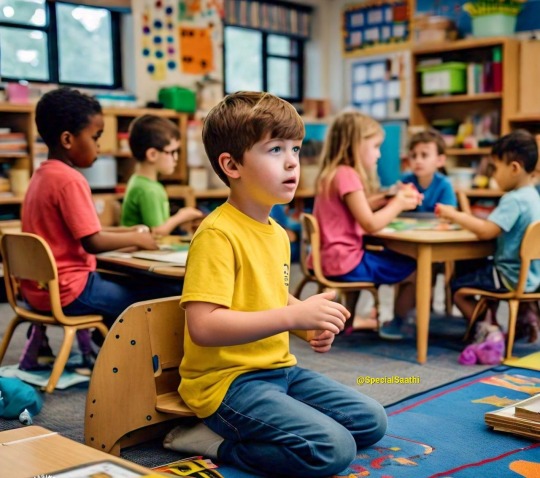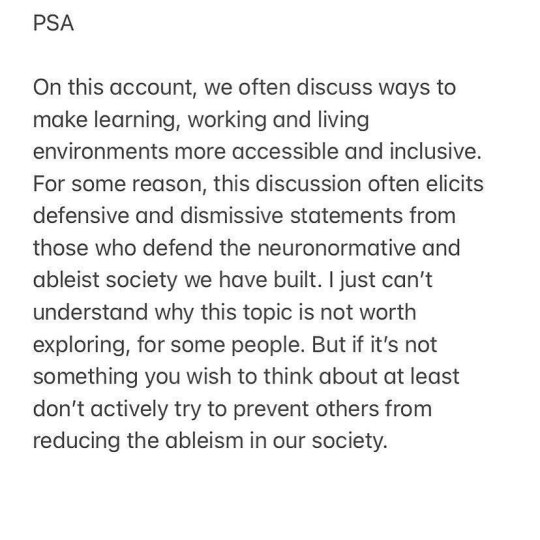#InclusiveLearning
Text
Check out this blog I'm featured in! Our team is working hard to find new ways to make learning more inclusive and accessible!
2 notes
·
View notes
Text
Inclusive Learning: The Power of Collaboration in a Child-Centric Approach
Inclusive education is about creating a learning environment that values diversity, promotes equity, and supports the unique needs of every child. A collaborative approach is essential in an inclusive school environment, where a child-centric approach is followed.
Today’s blog will shed light on the importance of a collaborative, child-centric approach. It will also encourage identifying and…

View On WordPress
#collaborativeapproachofteaching#childcentricapproach#collaboration#inclusivedevelopment#inclusivelearning#inclusiveschool
0 notes
Link
📚 Attention Deficit Hyperactivity Disorder (ADHD) is a condition that affects millions of children and often continues into adulthood. It includes a combination of persistent problems, such as difficulty sustaining attention, hyperactivity, and impulsive behaviour. For students with ADHD, maintaining focus in a traditional classroom setting can be a significant challenge. 🔍 Are you a teacher, parent or guardian seeking to understand and support easily distracted or ADHD students better? Or perhaps you're an individual living with ADHD who's looking for strategies to enhance your learning experience? 👉 We invite you to explore our latest blog post at Impact Teachers: https://impactteachers.com/blog/easily-distracted-adhd-students/. 📘 This comprehensive guide delves into the world of ADHD, offering valuable insights into the condition and practical strategies for managing distractions in the classroom. It provides an in-depth understanding of how ADHD affects learning and offers actionable tips for creating an inclusive, supportive learning environment. 💡 From understanding the importance of routine and structure to exploring different teaching methods that cater to diverse learning styles, this resource is packed with information designed to empower educators and learners alike. 🌐 Let's work together to create an educational landscape where every student, regardless of their challenges, can thrive and succeed. Knowledge is power - let's use it to make a difference in the lives of those living with ADHD.
0 notes
Link
📚🧠 Attention, educators and parents! We all know that every child is unique, each with their own strengths and challenges. However, for those who are easily distracted or have ADHD, the journey of learning can often feel like a winding road filled with hurdles. 🚧 ADHD (Attention Deficit Hyperactivity Disorder) is not just about being hyperactive or impulsive. It's a complex condition that affects a child's ability to focus, organise, and complete tasks. It's like trying to listen to the radio while someone keeps changing the station - frustrating, isn't it? 📻 But here's the good news: with understanding, patience and the right strategies, we can help these bright young minds to thrive in their educational journey. 🌟 At Impact Teachers, we believe in empowering educators with knowledge and tools to make a difference. We've put together an insightful blog post on how to support easily distracted and ADHD students in the classroom. From creating a structured environment to incorporating movement breaks, these strategies can help students stay focused and engaged. Check out our blog post here: https://impactteachers.com/blog/easily-distracted-adhd-students/ Remember, every child has the potential to shine brightly. Let's work together to create an inclusive learning environment where all students feel supported and understood. Because at the end of the day, it's not just about teaching them facts and figures - it's about nurturing their curiosity, creativity and confidence. 💫🎓
0 notes
Link
📚🧠 Attention, educators and parents! We all know that maintaining focus can be a challenge for some students, particularly those with ADHD. It's not just about being 'easily distracted', it's about understanding the unique way their brains process information. ADHD is not a one-size-fits-all condition. It manifests differently in every individual, making it crucial for us to understand and adapt our teaching methods to help these students thrive. We've stumbled upon an insightful article from Impact Teachers that delves into this topic in depth. It provides valuable tips and strategies to help manage distractions and create an optimal learning environment for students with ADHD. From creating a structured routine to incorporating physical activity into the day, these strategies are designed to cater to the unique needs of these learners. The article also emphasises the importance of positive reinforcement and building strong relationships with students. Whether you're a teacher looking for new strategies or a parent seeking understanding, this article is a must-read. Let's work together to create an inclusive and supportive learning environment for all our students. Check out the full article here: https://impactteachers.com/blog/easily-distracted-adhd-students/ Remember, every child has the potential to excel - it's up to us to provide them with the right tools and environment to do so. 🌟🎓
0 notes
Text

"Exploring Hindu Mythology: Bridging Cultural Gaps and Fostering Understanding"
Dear Parents,
In our diverse world, understanding and appreciating different cultures is essential for fostering empathy and inclusivity. That's why we're excited to introduce "Exploring Hindu Mythology," a collection of captivating tales that offer a window into the rich cultural heritage of Hinduism.
We understand that every family has its unique beliefs and traditions, and it's natural for parents to want their children to have a broad understanding of the world around them. "Exploring Hindu Mythology" isn't about imposing beliefs; it's about providing an opportunity for children to explore and appreciate diverse cultures in a respectful and inclusive manner.
By delving into the stories of Hindu mythology, children not only gain insights into ancient traditions but also learn valuable lessons about compassion, courage, and resilience—lessons that are universally relevant and beneficial for their personal development.
As promoters, our intention isn't to make parents feel upset or pressured. Instead, we aim to offer a resource that can enrich children's understanding of the world and promote cultural curiosity and empathy.
Whether Hinduism is a part of your family's beliefs or not, we invite you to consider "Exploring Hindu Mythology" as a valuable tool for sparking meaningful conversations and fostering a spirit of openness and understanding in your household.
Thank you for considering "Exploring Hindu Mythology" as a means of broadening your child's cultural horizons.
Keywords: Cultural Understanding, Hindu Mythology, Diversity, Inclusivity, Empathy, Personal Development, Cultural Heritage, Respectful Exploration, Family Beliefs.
#CulturalDiversity#HinduMythology#SharedValues#EmpathyEducation#CulturalAppreciation#FamilyConnections#CulturalAwareness#InclusiveLearning#GlobalPerspectives#ParentingJourney#amazon#bestsellerbook#meeramandakini#inspiration#motivation#childrensbooks
0 notes
Text
The Role of Education in Fostering Social Equality
Education has long been hailed as the cornerstone of societal progress, serving as a catalyst for economic growth, personal development, and cultural enrichment. However, beyond these individual benefits, education plays a pivotal role in fostering social equality. In an era marked by persistent inequalities, the transformative power of education emerges as a beacon of hope, offering pathways to dismantle barriers and cultivate a more equitable society. This article delves into the multifaceted role of education in promoting social equality, exploring its impact on access, empowerment, and societal change.
Access to Education:
Bridging the Opportunity Divide At its core, education serves as a fundamental human right, yet access to quality education remains unevenly distributed across socio-economic lines. Disparities in access perpetuate cycles of inequality, limiting opportunities for marginalized communities and perpetuating systemic injustices. In striving for social equality, addressing these disparities is paramount.
Initiatives aimed at expanding access to education, such as universal education programs and scholarships for underprivileged students, represent critical steps toward leveling the playing field. By removing financial barriers and providing resources to marginalized communities, these efforts empower individuals to pursue educational opportunities that were once out of reach. Moreover, leveraging technology to deliver education remotely has the potential to reach learners in remote areas or those unable to attend traditional schools due to various constraints.
However, ensuring access goes beyond mere enrollment numbers. It requires creating inclusive learning environments that accommodate diverse backgrounds and abilities. This involves embracing multicultural curricula, fostering inclusive pedagogies, and promoting diversity among educators. By acknowledging and celebrating differences, education becomes a tool for empowerment rather than exclusion.
Empowerment Through Education:
Nurturing Critical Consciousness Education not only equips individuals with knowledge and skills but also empowers them to critically engage with the world around them. Through education, individuals develop critical thinking, problem-solving, and communication skills essential for active citizenship and meaningful participation in society.
Central to this empowerment is the cultivation of critical consciousness—the ability to recognize and challenge social injustices. By fostering empathy, promoting dialogue, and encouraging civic engagement, education nurtures individuals who are not only aware of inequities but also equipped to advocate for change. In classrooms where diversity is embraced and dialogue is encouraged, students learn to appreciate different perspectives, challenge stereotypes, and confront prejudice.
Moreover, education serves as a platform for marginalized voices to be heard and valued. By incorporating diverse narratives into the curriculum and elevating underrepresented scholars, education validates the experiences of historically marginalized communities. This validation is crucial in fostering a sense of belonging and empowerment among those who have been marginalized or excluded.
Societal Change:
Education as a Catalyst for Equity Beyond its immediate impact on individuals, education plays a pivotal role in driving broader societal change. A well-educated populace is essential for the functioning of democracy, as informed citizens are better equipped to participate in governance, hold leaders accountable, and advocate for policies that promote equity and justice.
Furthermore, education has the power to disrupt intergenerational cycles of poverty and inequality. By equipping individuals with the skills and knowledge necessary for economic mobility, education serves as a pathway to upward social mobility. This, in turn, contributes to more equitable distribution of resources and opportunities within society.
Moreover, education has the potential to challenge entrenched power structures and dismantle systemic barriers to equality. By fostering critical inquiry and promoting social awareness, education empowers individuals to question prevailing norms and advocate for transformative change. Whether through grassroots activism, policy advocacy, or community organizing, educated individuals are instrumental in driving progress toward a more just and equitable society.
Challenges and Opportunities Ahead While education holds immense potential as a catalyst for social equality, numerous challenges persist. Funding disparities, inadequate infrastructure, and entrenched biases within educational systems continue to impede progress toward equitable access and outcomes. Moreover, the digital divide exacerbates inequalities, particularly in the wake of the COVID-19 pandemic, highlighting the urgency of addressing disparities in access to technology and internet connectivity.
Addressing these challenges requires a multifaceted approach that involves collaboration among governments, educators, communities, and stakeholders. Investing in education, both financially and ideologically, must be prioritized as a means of investing in the future of society. Moreover, efforts to promote inclusivity, diversity, and equity within educational institutions must be ongoing and comprehensive.
Conclusion
In conclusion, education stands as a powerful force for fostering social equality in the 21st century. By expanding access, nurturing empowerment, and driving societal change, education holds the key to creating a more just, inclusive, and equitable world. As we confront the challenges of our time, investing in education emerges not only as a moral imperative but also as a strategic imperative for building a brighter future for generations to come.
#EducationForEquality#EqualOpportunity#EmpowerThroughEducation#SocialJusticeEducation#InclusiveLearning#EquityInEducation#AccessToEducation
0 notes
Text
Going Global: Unlocking Success with eLearning Localization Services
Introduction
In today's interconnected world, reaching a global audience is essential for businesses and educational institutions alike. eLearning localization services play a pivotal role in breaking down language and cultural barriers. In this blog post, we'll explore the significance of eLearning localization, its benefits, and how it can help you expand your reach and impact.
Understanding eLearning Localization Services
Demystifying eLearning LocalizationeLearning localization involves adapting digital learning materials, including courses, modules, and content, to meet the specific cultural and linguistic needs of a target audience. It goes beyond mere translation to ensure content is relevant and culturally sensitive.
Why eLearning Localization MattersLocalization is vital for reaching diverse audiences effectively. It enhances the learning experience, promotes engagement, and fosters inclusivity by respecting learners' cultural backgrounds and preferences.
Benefits of eLearning Localization
Global Reach: Localization enables organizations to tap into new markets and audiences, expanding their global presence.
Enhanced Learning: Learners are more likely to engage with content that feels familiar and relatable, leading to better comprehension and retention.
Cultural Sensitivity: Localization ensures that content aligns with local customs, values, and sensitivities, avoiding potential cultural misunderstandings.
Compliance: For corporate training and compliance programs, localization ensures that content meets regional legal and regulatory requirements.
Localization Beyond Language
Multilingual Content: Translate and adapt content into multiple languages to reach a diverse global audience.
Cultural Nuances: Consider cultural nuances in design, imagery, examples, and scenarios to make content resonate with local learners.
User Experience: Ensure that the user interface and navigation elements are intuitive and user-friendly in different cultural contexts.
Effective eLearning Localization Strategies
Needs Analysis: Start with a thorough needs analysis to identify the target audience's preferences, language requirements, and cultural sensitivities.
Collaboration: Work closely with native speakers, subject matter experts, and localization professionals to ensure accuracy and cultural relevance.
Quality Assurance: Implement rigorous quality assurance processes to review and test localized content thoroughly.
Success Stories: Real-world Examples
Company X: Learn how Company X expanded its global market share by localizing its eLearning content.
Educational Institution Y: Discover how Educational Institution Y attracted international students by offering localized courses and materials.
Conclusion
eLearning localization services are a strategic investment for organizations and educational institutions looking to broaden their horizons and connect with a global audience. By tailoring content to local languages and cultures, you can foster engagement, inclusivity, and success in diverse markets.
To explore more about eLearning localization services and discover tailored solutions, visit Prodient's eLearning Localization Services.
#eLearningLocalization#GlobalAudience#CulturalSensitivity#MultilingualContent#GlobalReach#LocalizationServices#eLearningImpact#InclusiveLearning#GlobalExpansion
0 notes
Link
#AcademicPerformance#Animal-AssistedTherapy#BehaviorManagement#Canine-AssistedEducation#ClassroomDynamics#DogProgramsinSchools#DogsinEducation#emotionalsupportanimals#EmpathyandCompassion#InclusiveLearning#SchoolWell-being#SocialSkillsDevelopment#SpecialEducation#StressReduction#therapydogs
0 notes
Link
Unlock the full potential of students with learning disabilities with the right resources and strategies. Dive into our latest article to explore the holistic approaches and technological aids that can foster an inclusive and nurturing learning environment. Full article: https://learnfasttips.com/2023/09/08/empowering-students-with-learning-disabilities-resources-and-strategies/
0 notes
Text
youtube
Unlock Equity Tools with Dr. Berry as she delves into mastering intersectionality in K-12 education for student success. Discover powerful strategies to promote inclusivity, diversity, and equitable learning environments. Dr. Berry, an expert in education, provides actionable insights to empower educators and administrators. Learn how to bridge gaps, foster understanding, and uplift students of all backgrounds. Don't miss this insightful session on unlocking equity in education. Subscribe for more valuable content on inclusive learning and student success. Watch video now!
#Ep. 56 Unlock Equity Tools: Mastering Intersectionality in K-12 Education for Student Success#EducationForAll#EquityInEducation#InclusiveLearning#StudentSuccess#DiversityInEducation#EmpowerEducators#EquitableLearning#EducationalEquality#UnlockingEquity#BridgeTheGap#TeacherEmpowerment#EducationInsights#StudentDiversity#EducationForEveryone#InclusiveCurriculum#K-12 Education#k-12 education system#equity education#equity in education explained#Youtube
0 notes
Text
Explore best practices for digital accessibility to enhance learning experiences. Discover how Harbinger Group empowers inclusive learning through insightful blog posts. Learn how to create accessible content and ensure a seamless learning journey for all learners.
#DigitalAccessibility#InclusiveLearning#LearningExperiences#AccessibilityBestPractices#AccessibleContent#InclusiveEducation#EdTech#LearningTechnology#eLearning
0 notes
Photo

PSA On this account, we often discuss ways to make learning, working and living environments more accessible and inclusive. For some reason, this discussion often elicits defensive and dismissive statements from those who defend the neuronormative and ableist society we have built. I just can’t understand why this topic is not worth exploring, for some people. But if it’s not something you wish to think about at least don’t actively try to prevent others from reducing the ableism in our society. When we speak of the rights of children, we are not trying to take away the rights of parents and teachers. They are not two sides of a scale, where more to one means less to the other. When we defend the rights of children to learn in an inclusive environment this is not “teacher bashing.” When we defend a child’s right to a safe and loving home, we are not “mom-shaming.” We cannot change what we don’t acknowledge. Also, from my perspective, we ARE defending the rights of parents and teachers to work and live a more fulfilling and meaningful life. Parents and teachers who agree with our philosophies, find our page supportive of a journey that they often feel alone on. Parenting and teaching from a child-led perspective is easier and more rewarding than always trying to force kids not to be kids. It’s the same with inclusiveness. When we work towards more inclusive environments for everyone, everyone feels a greater sense of belonging. We’re not going to wave a wand and make the whole world, loving, accepting and inclusive but for some of us it’s important to try. So please stop getting in our way and wasting our time with arguments about the “why?” If you do not understand why inclusive learning, living and working spaces are important, at least don’t sabotage others attempts to make society a little more comfortable, for everyone. J. Milburn #responsiveparenting #jmilburn #childism #inclusiveeducation #inclusivelearning #ableism #childadvocate #accessiblelearning #neurodivergent #neurodiversity #stopbeingabarrier https://www.instagram.com/p/Cf6T0-UAZ08/?igshid=NGJjMDIxMWI=
#responsiveparenting#jmilburn#childism#inclusiveeducation#inclusivelearning#ableism#childadvocate#accessiblelearning#neurodivergent#neurodiversity#stopbeingabarrier
1 note
·
View note
Photo

Sparkle up your little one’s bedroom with the VEMA Starry Sky Wall Art - Fibre Optic Panel. The perfect product to transform a bedroom into a magical universe. ⭐
#Playlearn#knowgrowsmile#playkind#sensorygrowth#sensoryplay#sensoryproducts#specialneedskids#inclusivelearning#playroomdesign#positiveparenting
0 notes
Text
"The Future of Education: Virtual Reality in Learning Environments"
In the ever-evolving landscape of education, virtual reality (VR) has emerged as a transformative force, reshaping the way students learn and interact with information. This article delves into the immersive world of virtual reality and its profound impact on the future of education.
Introduction: Virtual reality, once a concept confined to science fiction, has become a powerful tool in the…
View On WordPress
0 notes
Text
Charting the Course: Shaping a New Zealand's Literacy and Numeracy Strategy for 2024-2028
Dive into the evolution of New Zealand's Literacy and Numeracy Strategy for 2024-2028. Discover key considerations for developing an innovative, inclusive, and forward-thinking educational framework that builds on past successes
New Zealand’s Literacy and Numeracy Strategy
With a change of government recently, I am hopeful that we may be able to embark on shaping a new Literacy, language and Numeracy (LLN) Implementation Strategy for 2024-2028. With this in mind, reflecting on New Zealand’s previous strategy from 2015-2019 is not just instructive but essential.
Led by the Tertiary Education Commission (TEC), this…

View On WordPress
#DigitalLiteracy#EducationalInnovation#FutureOfEducation#InclusiveLearning#LiteracyAndNumeracy#NZEducation
0 notes